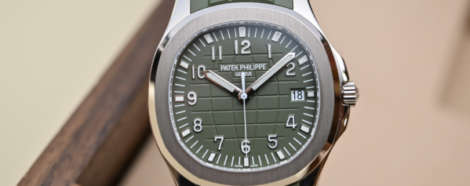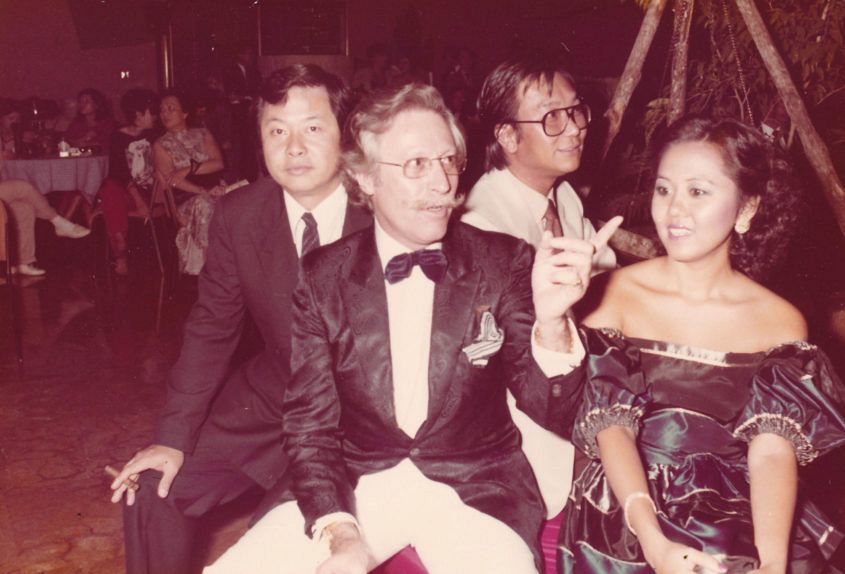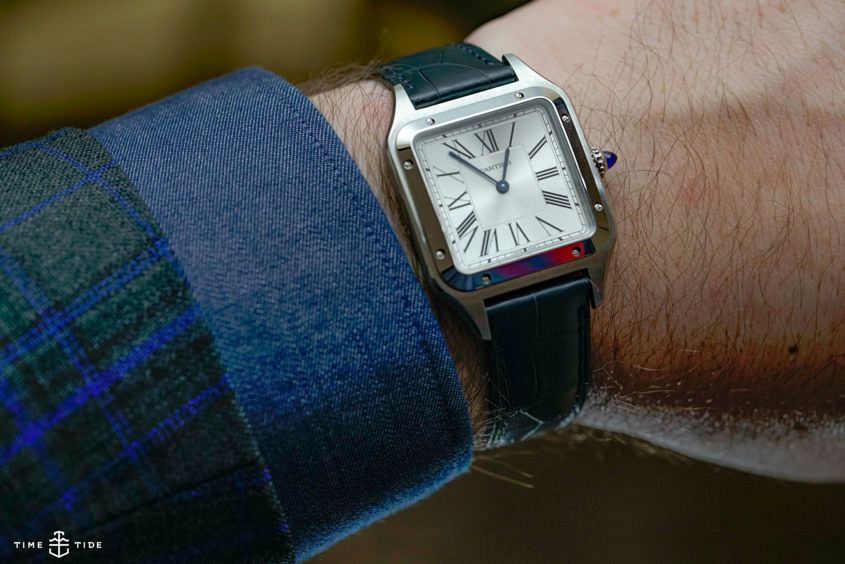Hands-on – Patek Philippe Aquanaut Jumbo 5168G with Khaki Green Dial
Celebrating the 20th anniversary of the Aquanaut in 2017, Patek Philippe presented the Jumbo Ref. 5168G in white gold with a larger diameter of 42.2mm, the most Jumbo size of this family to date and the first one to be housed in a white gold case. The fashionable blue dial of the 2017 model now has a sibling with a cool khaki green dial and matching “tropical” rubber strap. In essence, the exact same watch as the 2017 model with a green strap and dial, the khaki green dial adds a safari/adventure/military mood to the watch underlining its mission as Patek’s everyday sports watch.

 It’s easy to forget or overlook the magnitude of what Hublot has achieved with their materials innovation — the scale and scope of their sapphire pieces is impressive to say the least, and their use of ceramic is amongst the most interesting in the business (which is no small feat given that every brand and its dog is making the most of the material at the moment). What really stands out with Hublot’s ceramic watches is their vivid tones. Last year’s Red Magic was one of the real bright spots (literally), with a hue that no other brand has managed to match. And this year’s Blue Magic doubles down on the trick — the 45mm sports chronograph is an outragesouly, awesomely bright blue. Polished blue ceramic aside, it is business as usual — the open dial, the one-click strap (blue, obvs) and the HUB1242 chronograph movement. This watch is limited to 500 pieces. It’s also a watch that leaves me wondering: what ceramic wonder will Hublot do next? Hublot Big Bang Unico Blue Magic price and availability Hublot Big Bang Unico Blue Magic, limited to 500 pieces, $27,000
It’s easy to forget or overlook the magnitude of what Hublot has achieved with their materials innovation — the scale and scope of their sapphire pieces is impressive to say the least, and their use of ceramic is amongst the most interesting in the business (which is no small feat given that every brand and its dog is making the most of the material at the moment). What really stands out with Hublot’s ceramic watches is their vivid tones. Last year’s Red Magic was one of the real bright spots (literally), with a hue that no other brand has managed to match. And this year’s Blue Magic doubles down on the trick — the 45mm sports chronograph is an outragesouly, awesomely bright blue. Polished blue ceramic aside, it is business as usual — the open dial, the one-click strap (blue, obvs) and the HUB1242 chronograph movement. This watch is limited to 500 pieces. It’s also a watch that leaves me wondering: what ceramic wonder will Hublot do next? Hublot Big Bang Unico Blue Magic price and availability Hublot Big Bang Unico Blue Magic, limited to 500 pieces, $27,000 Editor’s note: Not many know it, but Australia was one of the most important markets for Hans Wilsdorf as he built the businesses of Rolex and Tudor in the early part of the 20th century. Tudor watches have been in Australia for the best part of 100 years, proving that Australians know great value when they see it — value the brand continues to offer today. While our American and English cousins have only recently rediscovered the joys of Tudor watches (relaunching in the American market in 2013 and the UK in 2014), Australia can stand proud in the knowledge that we’ve been wearing watches emblazoned with the Tudor shield and Tudor rose for the last 83 years. Tudor first came to Australia in 1932. History shows that it was merely eight years after Hans Wilsdorf registered the trademark “The Tudor” in 1926. The Australian distributor was the jewellery firm Willis & Sons – who had been importing, wholesaling and manufacturing jewellery since 1858. While Australia in the ’30s wasn’t the centre of the watchmaking world, we did have a pretty significant expertise and background in jewellery, thanks to the gold rush – so it’s not entirely surprising that we would…
Editor’s note: Not many know it, but Australia was one of the most important markets for Hans Wilsdorf as he built the businesses of Rolex and Tudor in the early part of the 20th century. Tudor watches have been in Australia for the best part of 100 years, proving that Australians know great value when they see it — value the brand continues to offer today. While our American and English cousins have only recently rediscovered the joys of Tudor watches (relaunching in the American market in 2013 and the UK in 2014), Australia can stand proud in the knowledge that we’ve been wearing watches emblazoned with the Tudor shield and Tudor rose for the last 83 years. Tudor first came to Australia in 1932. History shows that it was merely eight years after Hans Wilsdorf registered the trademark “The Tudor” in 1926. The Australian distributor was the jewellery firm Willis & Sons – who had been importing, wholesaling and manufacturing jewellery since 1858. While Australia in the ’30s wasn’t the centre of the watchmaking world, we did have a pretty significant expertise and background in jewellery, thanks to the gold rush – so it’s not entirely surprising that we would… This is one of those watches that makes so much sense I’m amazed it didn’t exist until now. But before we dive into the details of the IWC Big Pilot Edition ‘Right-Hander’, let’s step back and have a quick recap on the Big Pilot. The Big Pilot is a watch with two distinct histories. The first iteration of this story was the original watch, made as a navigational tool for wartime use. In this context, size = clarity and reliability. The civilian story of the Big Pilot begins in 2002, with the reference 5002. IWC’s revival of their historic design was perfectly pitched for the times, as big watches were all the rage, but few had the presence of IWC’s 46mm aviator. Seventeen years on and the Big Pilot is a staple of IWC’s lineup, offered in many material, complication and dial configurations over the years. But never — until now — a right-handed version. Quick primer on right and left-handed watches. Watches are intended to be worn on the less dominant hand, which, for most people, is the left. Ergonomics and good design dictates that a watch worn on the left hand should have its crown on the right…
This is one of those watches that makes so much sense I’m amazed it didn’t exist until now. But before we dive into the details of the IWC Big Pilot Edition ‘Right-Hander’, let’s step back and have a quick recap on the Big Pilot. The Big Pilot is a watch with two distinct histories. The first iteration of this story was the original watch, made as a navigational tool for wartime use. In this context, size = clarity and reliability. The civilian story of the Big Pilot begins in 2002, with the reference 5002. IWC’s revival of their historic design was perfectly pitched for the times, as big watches were all the rage, but few had the presence of IWC’s 46mm aviator. Seventeen years on and the Big Pilot is a staple of IWC’s lineup, offered in many material, complication and dial configurations over the years. But never — until now — a right-handed version. Quick primer on right and left-handed watches. Watches are intended to be worn on the less dominant hand, which, for most people, is the left. Ergonomics and good design dictates that a watch worn on the left hand should have its crown on the right… If you’re reading this, you probably know who Gérald Genta is, and if you don’t, you probably recognise the name. He was the most prolific watch designer of the 20th century, having been the source of inspiration for the Audemars Piguet Royal Oak, the Patek Philippe Nautilus and the Omega Constellation. He designed for everyone, from Universal Genève and IWC, to Cartier and Bulgari, leaving his fingerprints on the majority of the most loved watches in production today. Considering his level of impact, it is exciting when more detail is uncovered about the artist’s life, which has happened through the Gérald Genta Heritage Association and a retailer Mr Genta had a close relationship with, The Hour Glass. Together they have brought to light a collection of photographs of Gérald Genta taken over several decades in Singapore and Malaysia. The full story can be found at The Hour Glass here.
If you’re reading this, you probably know who Gérald Genta is, and if you don’t, you probably recognise the name. He was the most prolific watch designer of the 20th century, having been the source of inspiration for the Audemars Piguet Royal Oak, the Patek Philippe Nautilus and the Omega Constellation. He designed for everyone, from Universal Genève and IWC, to Cartier and Bulgari, leaving his fingerprints on the majority of the most loved watches in production today. Considering his level of impact, it is exciting when more detail is uncovered about the artist’s life, which has happened through the Gérald Genta Heritage Association and a retailer Mr Genta had a close relationship with, The Hour Glass. Together they have brought to light a collection of photographs of Gérald Genta taken over several decades in Singapore and Malaysia. The full story can be found at The Hour Glass here.



 Now that we’re more than halfway through, I think we can all admit that 2019 has been a bit of an odd one, as far as years go. If you had told past Felix that a slender steel quartz Cartier would be one of the best watches of the year, he would have scoffed. But here we are, and here is the Cartier Santos-Dumont. It is, as you’ll have surmised, a slender steel quartz watch and it’s quite incredible. To my mind, what’s great about this watch is the fact that it showcases everything that’s great about Cartier — namely, design — and doesn’t confuse the offering with anything else. Santos-Dumont is, in fact, a new line for the brand — with a name and a shape inspired by Alberto Santos-Dumont, and his specially commissioned watch. What’s more interesting, though, is the change of gears this watch represents for the brand’s stylistic and strategic direction. It’s pared back, simple and restrained. All good things for a luxury brand in 2019. And while it would be easy to put all these attributes together and come up with an uninspired piece, the Cartier Santos-Dumont manages to avoid these pitfalls. Partially because the case…
Now that we’re more than halfway through, I think we can all admit that 2019 has been a bit of an odd one, as far as years go. If you had told past Felix that a slender steel quartz Cartier would be one of the best watches of the year, he would have scoffed. But here we are, and here is the Cartier Santos-Dumont. It is, as you’ll have surmised, a slender steel quartz watch and it’s quite incredible. To my mind, what’s great about this watch is the fact that it showcases everything that’s great about Cartier — namely, design — and doesn’t confuse the offering with anything else. Santos-Dumont is, in fact, a new line for the brand — with a name and a shape inspired by Alberto Santos-Dumont, and his specially commissioned watch. What’s more interesting, though, is the change of gears this watch represents for the brand’s stylistic and strategic direction. It’s pared back, simple and restrained. All good things for a luxury brand in 2019. And while it would be easy to put all these attributes together and come up with an uninspired piece, the Cartier Santos-Dumont manages to avoid these pitfalls. Partially because the case…